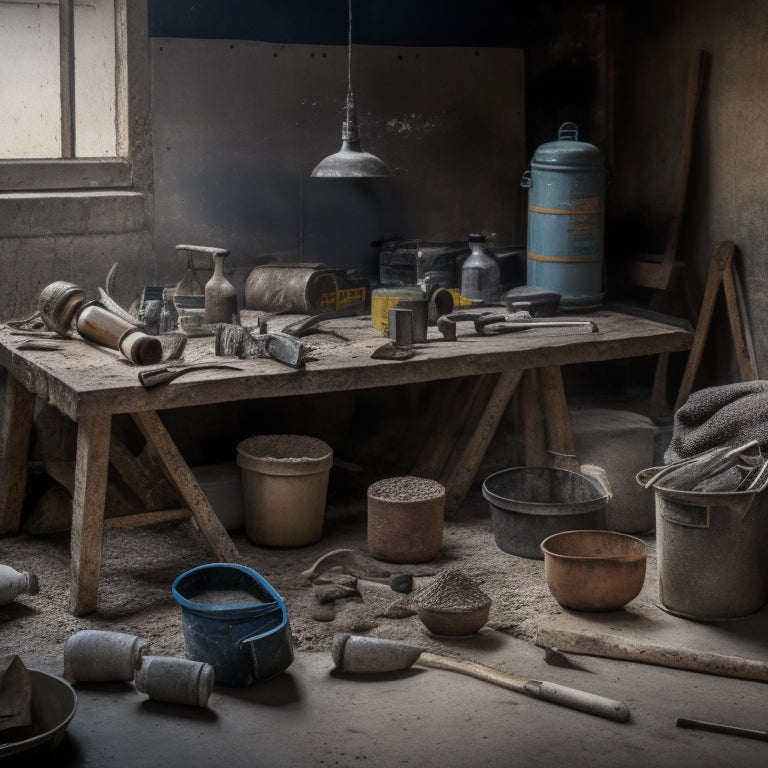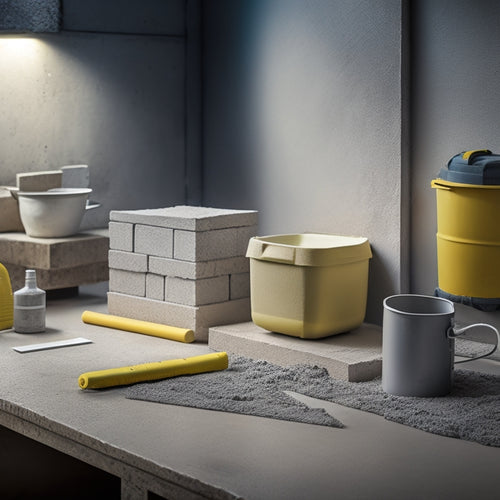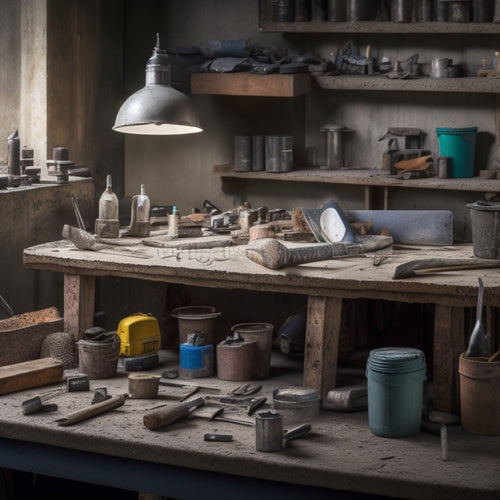
10 Budget-Friendly Tools for Concrete Repair
Share
You'll need a range of specialized tools to tackle concrete repairs effectively, and investing in the right ones doesn't have to break the bank. Consider affordable alternatives like portable concrete mixers, manual mixing techniques, and sturdy mixing tools for preparing your concrete. For patching compounds, use trowels, putty knives, and edgers for a professional finish. Effective scrapers, trowels, and drilling tools can be found at budget-friendly prices. Sealant applicators, leveling tools, and chisel sets can also be sourced economically. By exploring these cost-effective options, you'll be well-equipped to tackle your concrete repair project with confidence - and discover the specific details that will make all the difference.
Key Takeaways
- Portable concrete mixers and manual mixing techniques offer cost-effective alternatives to traditional cement mixers.
- Trowels, putty knives, and edgers are essential tools for applying and smoothing patching compounds in concrete repair.
- DIY scrapers made from steel or carbide-tipped materials can effectively remove old, damaged concrete for repair.
- Affordable trowel options, including steel, aluminum, and fiberglass, cater to different project needs and budgets.
- Budget-friendly drill bits, such as carbon steel or diamond-coated, can efficiently drill into concrete for repair or new joints.
Essential Cement Mixer Alternatives
When tackling concrete repair projects, you'll often find yourself in need of a reliable cement mixer to combine the perfect blend of cement, sand, and water. While investing in a high-end cement mixer mightn't be feasible, you can still achieve professional-grade results with alternative solutions.
Portable concrete mixers, for instance, offer a cost-effective and convenient option for small to medium-sized projects. These compact units are designed for ease of transport and can be easily stored when not in use.
If you're working on an extremely tight budget, manual mixing techniques can also be employed. This approach requires more physical labor, but can be just as effective.
To achieve a consistent mix, use a sturdy mixing stick or trowel to combine the ingredients in a large bucket or wheelbarrow. Start by mixing the dry components (cement, sand, and aggregate) before gradually adding water. Be sure to mix in a consistent, figure-eight pattern to guarantee a uniform blend.
With practice and patience, you can master manual mixing techniques and produce high-quality concrete repairs without breaking the bank.
Affordable Trowel Options for Repair
You've mixed your concrete to perfection, now it's time to apply it with a reliable trowel. When selecting an affordable trowel for concrete repair, consider the materials and their benefits.
Steel trowels provide durability and strength, making them ideal for large-scale projects, while aluminum trowels offer lightweight handling and rust resistance. Fiberglass trowels, on the other hand, offer a balance between strength and weight.
When it comes to trowel size selection, consider the area you're working on and the type of repair. A smaller trowel (8-10 inches) is perfect for tight spaces and detailed work, while a larger trowel (12-14 inches) is better suited for bigger areas and more substantial repairs.
A medium-sized trowel (10-12 inches) is a versatile option for most repair jobs.
In your trowel materials comparison, also consider the handle type. A wooden or fiberglass handle provides a comfortable grip, while a metal handle offers added strength.
Ultimately, the right trowel for the job will depend on your specific needs and preferences.
DIY Concrete Scraper Solutions
Concrete scraper tools are a must-have for effective concrete repair, as they enable you to remove old, damaged concrete and prepare the surface for new applications.
When it comes to scraper materials, you'll find that steel and carbide-tipped scrapers are the most effective. Steel scrapers are ideal for removing thin layers of concrete, while carbide-tipped scrapers are better suited for thicker, more stubborn layers.
As a DIY enthusiast, you can create your own scraper solutions using everyday materials. For instance, you can attach a metal blade to a wooden or fiberglass handle to create a makeshift scraper. Additionally, you can repurpose old screwdrivers or chisels as makeshift scrapers.
When using these DIY techniques, it's vital to wear protective gear, including gloves and safety glasses, to prevent injury.
Regardless of the scraper material or DIY technique you choose, it's important to maintain a consistent angle and apply steady pressure to guarantee efficient removal of damaged concrete.
Budget-Friendly Sealant Applicators
Five essential tools in your concrete repair arsenal are budget-friendly sealant applicators, which guarantee a smooth, even finish and prevent further damage.
You can't afford to overlook the importance of proper sealant application techniques when it comes to concrete repair. Budget sealant brands like Sika, Loctite, and DAP offer high-quality products at an affordable price point.
When selecting a sealant applicator, consider the type of sealant you're working with, as well as the size and shape of the area you need to cover.
For smaller areas, a caulk gun is a great option. It allows for precise control and is easy to maneuver into tight spaces.
For larger areas, a sealant spreader or squeegee is a better choice. These tools help you achieve an even, consistent finish and are often more cost-effective than using multiple caulk guns.
Regardless of the tool you choose, make sure to follow the manufacturer's instructions for proper use and application.
With the right sealant applicator and technique, you'll be able to achieve professional-looking results without breaking the bank.
Cost-Effective Chisel Sets
When selecting a cost-effective chisel set for concrete repair, you'll want to evaluate the variety of chisel types included, as different tasks require specific edge geometries and angles.
A set that offers a range of chisel types, such as flat, round, and pointed, will provide you with the versatility you need to tackle various projects.
Additionally, look for sets with ergonomic handle options, which can reduce fatigue and improve control during extended use.
Chisel Type Variety
You'll find that having a variety of chisel types in your toolkit is essential for tackling different concrete repair tasks. A cost-effective chisel set should include a mix of flat, round, and pointed chisels to handle various tasks such as breaking, prying, and scraping.
Flat chisels are ideal for breaking up large areas of concrete, while round chisels are better suited for curved surfaces. Pointed chisels, on the other hand, are perfect for precision work and getting into tight spaces.
When selecting a chisel set, consider the material and construction quality. Look for chisels made from high-carbon steel or alloy steel for durability and strength.
Additionally, pay attention to the handle design and material, as it affects chisel safety practices. Always follow proper chisel maintenance tips, such as cleaning and storing chisels after use, to extend their lifespan and prevent damage.
Ergonomic Handle Options
While selecting a cost-effective chisel set, the ergonomic handle options available can greatly impact your concrete repair experience. You'll want to take into account sets with ergonomic grips that provide comfortable handling, reducing fatigue and improving control.
Look for handles made from durable, shock-absorbing materials that can withstand the rigors of concrete chiseling. A well-designed ergonomic handle will allow you to maintain a secure grip, even in wet or slippery conditions. This is particularly important when working with heavy chisels or in confined spaces.
Additionally, ergonomic handles can help reduce the risk of hand and wrist injuries, common issues associated with repetitive chiseling motions. When evaluating ergonomic handle options, pay attention to factors such as grip texture, handle shape, and balance.
A comfortable, well-balanced handle will enable you to work more efficiently and effectively, allowing you to complete your concrete repair project with greater precision and confidence. By prioritizing ergonomic handle options, you can optimize your chisel set for maximum performance and comfort.
Inexpensive Concrete Drill Bits
Drilling into concrete can be an intimidating task, especially when cost is a concern. However, with the right drill bits, you can tackle concrete drilling techniques without breaking the bank. Inexpensive concrete drill bits are available in various materials, each with its own strengths and weaknesses.
Carbon steel drill bits are a cost-effective option for drilling into soft concrete. They're ideal for small projects and can be used with a hammer drill or rotary hammer.
Diamond-coated drill bits, on the other hand, are more expensive but offer superior performance in hard concrete. They're worth the investment if you plan to drill into concrete regularly.
When choosing drill bits, consider the type of concrete you'll be working with. For example, if you're drilling into old, cracked concrete, a tungsten carbide drill bit may be the best option.
It's important to select the right drill bit material for your project to guarantee efficient drilling and minimize wear on your drill. By doing so, you'll achieve professional results without overspending on high-end drill bits.
Economical Sanding Block Tools
Sanding concrete surfaces can be a labor-intensive process, but it's vital for achieving a smooth finish. When it comes to economical sanding block tools, you'll want to focus on block materials that provide superior performance without breaking the bank.
Look for sanding blocks made from durable materials like aluminum oxide or silicon carbide, which offer excellent abrasion resistance and can withstand the rigors of concrete sanding.
To get the most out of your sanding block tools, it's important to master various sanding techniques. Start with coarse grits (around 16-24) for aggressive material removal, then progress to finer grits (36-60) for smoothing and polishing.
Always work in small, circular motions, applying moderate pressure to avoid creating scratches or swirl marks.
When choosing an economical sanding block, consider the block's size and shape. Rectangular blocks are ideal for flat surfaces, while circular blocks are better suited for curved or irregular surfaces.
Additionally, opt for blocks with Velcro-backed sanding pads for easy pad replacement and reduced waste. By selecting the right block materials and mastering various sanding techniques, you can achieve professional-grade results without overspending.
Low-Cost Concrete Cutting Saws
When tackling concrete repair projects, you'll inevitably encounter situations where cutting through concrete is necessary, and that's where low-cost concrete cutting saws come in.
These saws are fundamental for making precise cuts in concrete, allowing you to remove damaged sections or create new joints. To get the most out of your saw, it's important to master concrete cutting techniques, such as using the correct blade angle and applying gentle to moderate pressure.
Regular saw maintenance is also crucial to guarantee peak performance and extend the lifespan of your saw.
Saw maintenance tips include cleaning the saw blade and guard after each use, lubricating moving parts, and storing the saw in a dry place. Additionally, it's necessary to choose the right blade type and size for your specific project, as this will affect the quality of the cut and the saw's performance.
Handy Patching Compound Tools
After making precise cuts with your low-cost concrete cutting saw, you'll often need to fill in gaps and repair damaged areas with a patching compound. To guarantee a strong and durable bond, you'll need the right tools for the job.
| Tool | Description | Cost |
|---|---|---|
| Trowel | Used for applying and smoothing patching compound | $5-$10 |
| Putty Knife | Ideal for filling small gaps and holes | $2-$5 |
| Edger | Perfect for creating clean edges and lines | $10-$20 |
| Mixing Bucket | A must-have for mixing and storing patching compound | $5-$10 |
| Scraper | Used for surface preparation and removing old adhesive | $5-$10 |
When it comes to patching techniques, surface preparation is key. You'll need to guarantee the area is clean, dry, and free of any old adhesive or debris. Use your scraper to remove any unwanted material, and then apply your patching compound according to the manufacturer's instructions. With the right tools and a bit of practice, you'll be able to achieve professional-looking results without breaking the bank.
Cheap yet Reliable Leveling Tools
Proper leveling is crucial to guarantee a smooth, even surface, and it's important to get it right, especially when working with concrete. You'll need reliable tools to guarantee accurate leveling, and you don't have to break the bank to get them. A budget-friendly option is a spirit level, which is a must-have for any concrete repair job. This tool allows you to check the surface's horizontal and vertical alignment, guaranteeing that your repairs are precise and even.
When it comes to surface preparation, a leveling rake is indispensable. This tool helps you remove imperfections and create a uniform surface, making it ideal for large areas.
You can also use a screed board, which is a long, straight edge that helps you level and smooth out the surface. When combined with a leveling rake, this tool guarantees a perfectly even surface.
Frequently Asked Questions
Can I Use a Regular Drill for Concrete Repair Projects?
You can use a regular drill for concrete repair projects, but it's essential to choose the right concrete drill types and employ effective drilling techniques to avoid damaging the surrounding concrete or the drill itself.
What Safety Gear Is Necessary for Concrete Repair Tasks?
You think you're tough, but concrete dust and debris can bring you to your knees. Don't be reckless; you're smart to prioritize safety precautions, so strap on personal protective equipment like gloves, goggles, and a dust mask to shield yourself from harm.
How Do I Clean and Maintain My Concrete Repair Tools?
When you're done with a concrete repair task, you'll want to properly clean and maintain your tools to extend their lifespan; store them in a dry place, and follow maintenance tips like lubricating moving parts and sharpening cutting edges.
Can I Rent Concrete Repair Tools Instead of Buying Them?
You're a master conductor, orchestrating a symphony of concrete repair, and renting tools is like borrowing a virtuoso's instrument - it's a cost-effective way to access specialized repair equipment without committing to a purchase, allowing you to fine-tune your skills.
What Is the Average Cost of a Concrete Repair Project?
When estimating a concrete repair project, you'll need to contemplate various cost factors, including material costs, labor costs, and equipment rental fees, to accurately determine the average cost, which can range from $500 to $5,000 or more, depending on project complexity and size.
Conclusion
You've got the tools to tackle that concrete repair job without breaking the bank! With these 10 budget-friendly options, you can mix, scrape, trowel, seal, chisel, sand, cut, patch, and level like a pro. Your wallet will thank you, and your concrete will shine like new. Now, get out there and concrete like a boss - your DIY project is waiting!
Related Posts
-

7 Must-Have Tools for Concrete Repair Organization
To effectively organize your concrete repair projects, you'll need a thorough toolkit that includes a well-planned st...
-

What Tools Do I Need for Concrete Block Laying
You'll need a thorough set of tools to guarantee accurate, efficient, and professional concrete block laying. Essenti...
-

Top Tools for Concrete Repair Success
When it comes to concrete repair success, you'll need a well-stocked toolkit with essential hand tools like trowels, ...


